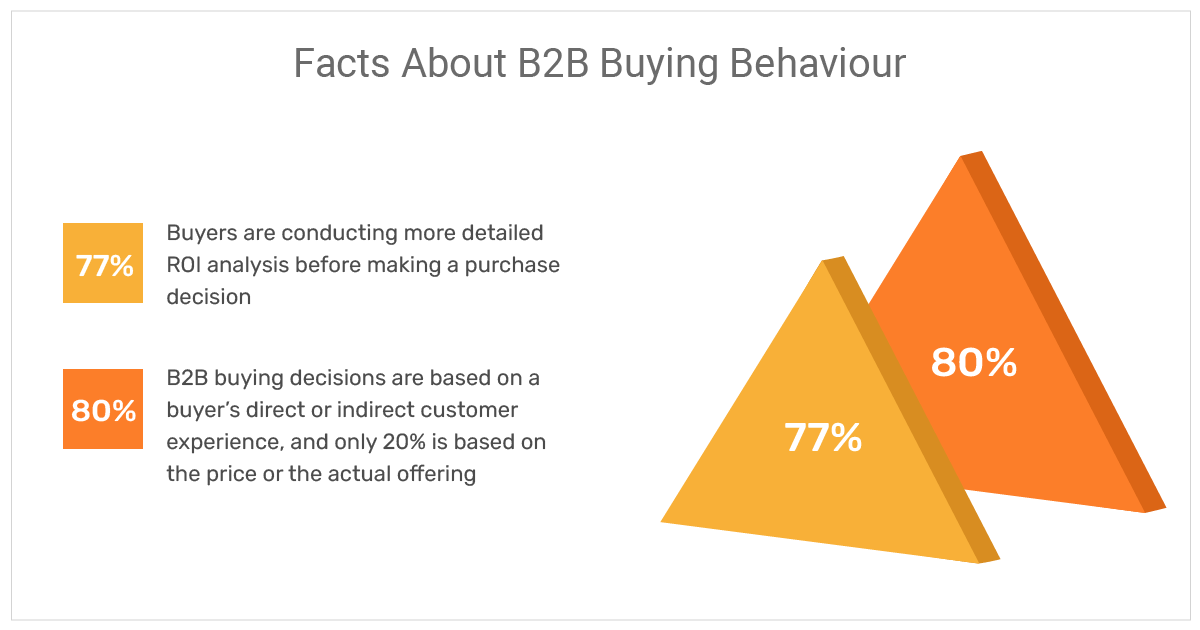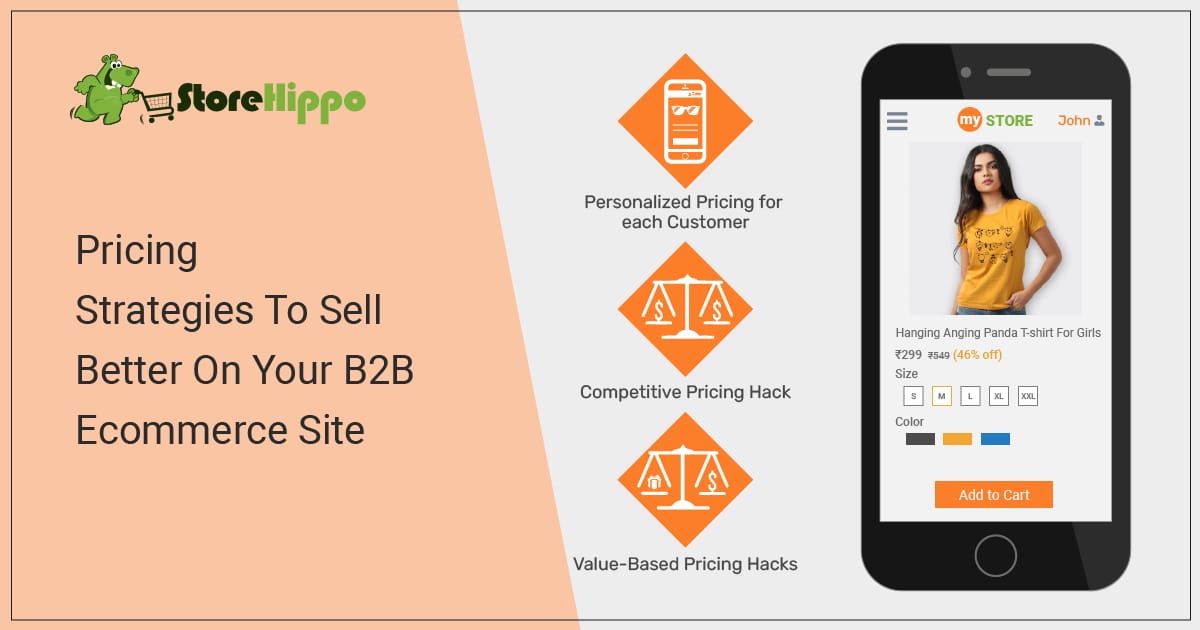As a B2B ecommerce store owner, have you ever given attention to customer purchase motivation? Wonder what B2B customers evaluate before buying a product? Well, there are plenty of factors that any buyer considers. However, the No. 1 factor is PRICE v/s VALUE.
B2B buyers are logic buyers and consult a handful of decision-makers. So to prove your worth, an epic pricing strategy is the primary need. It should be compelling enough to close a million-dollar client.
For an effective pricing strategy, you should first know about your customers i.e.
Interests and Preferences for offering personalized pricing
Customer buying stage (new or have tried)
Buyers want B2B ecommerce sites to deliver market-relevant prices for fast purchase decisions
You should also keep an eye on your competitor’s prices. Like what benefit they offer against the price, what discounts they are offering to appeal to customers, etc.

77% of Buyers are conducting more detailed ROI analysis before making a purchase decision.
80% of B2B buying decisions are based on a buyer’s direct or indirect customer experience, and only 20% is based on the price or the actual offering
Now when you have an idea about customer buying psychology, you are ready to decode the pricing hacks.
Table of Contents
3 Pricing hacks you can copy on your B2B ecommerce site
1. Personalized pricing for each customer
It is a practice wherein you use customer data to personalize your prices. Before offering personalized B2B ecommerce pricing, you need to gather customer data as highlighted below:
Demographics: Includes age, gender, income
Customer Interaction: Products pages they visited, product ordered, wishlist items
Spending Habits: Customer online spending on your website
Customer Shopping channel: Device, location
Benefits of personalized pricing
Customizing prices boost customer engagement and Loyalty
Faster Customer Buying Cycle
Deepens customer and Business Relationships
How to personalize your prices? Here are some examples-
Apart from personalizing prices based on customer data, you can even offer custom prices based on their order value.
For example: If a corporate is buying 100 chairs from your B2b ecommerce store. Then, you can offer a 20% off on the total price to encourage them to buy again in future.
Create personalized experiences with StoreHippo B2B ecommerce platform
With StoreHippo ecommerce software, you can offer personalized pricing based on customer order quantity and value.
StoreHippo offers a slab-based pricing feature, under which you can set quantity slab on each product. For customers who order in heavy quantities, you can offer discounted prices.
Another StoreHippo price-related feature is price overrides. You can customize prices for each customer by using different types of price overrides. Such as Increment fixed, Discount fixed, Plain override.
2. Competitive pricing hack
Competitor-based pricing relies on checking to see what prices similar companies have offered for their products and then pricing your products similarly. Pricing focuses solely on the public information about competitor’s prices, not customer value
Benefits of competitive pricing strategy
Steal the attention of competitors customers
Little research is required as competitors have already done it for you
Accuracy in prices
How to set competitive based pricing?
B2B ecommerce stores have 3 options to set prices-
- Above the competitor price: In this option, your product/services should be phenomenal and must have a good market reputation, to persuade customers to choose you over competitors.
- Below the competitor’s price: This technique is used by B2B ecommerce startups to gain new customers and build long term customer relationships. Although, businesses have to take an initial loss to make a profit.
- Equal to competitors price: Here business mimics the prices set by the competitors. Main idea is to retain present customers, by matching the prices with competitors. Example: Many retailers like Walmart have copied Amazon’s holiday season pricing in 2014. So that their customers don’t run to Amazon for low prices.
The best strategy is to use a combination of pricing hacks. Test multiple pricing models and figure out which adds value to your customers and enterprise.
3. Value-Based pricing hacks
Value-based pricing is a model where customers are charged for the value/benefits they get from a product. Customers pay based on quality, durability, customer service, brand loyalty, lifetime returns policy, transparent pricing, product USPs.
Such customers would return to your store if the product meets expectations.
Tip: To successfully implement value-based pricing, first study customer demands.
Example of Value-based pricing
Let’s say there are two B2B ecommerce stores selling office furniture and other supplies. Store 1 sells office chairs at Rs 2,000. And store 2 sells the same type of chair at Rs 1000.
Store 1 promotes quality and warranty of their chairs to attract customers. Whereas, Store 2 uses price as a weapon to attract customers and fails to display the product features/benefits of buying their chairs.
Reasons behind purchasing from Store 1, despite high prices, can be good online reputation, great customer service, compelling marketing strategy, brand awareness and high customer rating.
To conclude, your B2B ecommerce business should build customer-focused products. Your product should solve customer’s problems like nobody else in the market.
Types of value-based pricing
Good-value pricing: It is a combination of quality product and affordable prices.
Value-added pricing: An approach to sell at premium rates by adding additional valuable features.
Benefits of Value-Based pricing in bringing sales
Empowers Brand Identity & Reputation
Bolster profit margins
Final Takeaways
By following the above 3 pricing hacks, you will notice astonishing results such as -
Fast conversions & more returning customers
Boost in customer loyalty
Increase in customers spending on your website
Thankfully, StoreHippo has inbuilt dynamic pricing settings, which allows B2B ecommerce stores to adjust product pricing according to customer’s location, device, cart items, recent products, browsing behavior, etc.
Moreover, with multi store ecommerce functionality, you can personalize the customer experience by creating sub stores.
Substores are highly recommended if you have a diverse audience that lives in different countries, speaks different languages, and uses different currencies.
For high-level personalization, you can use StoreHippo marketing tools like unified notifications and email notifications to inform customers of the latest offers. You can even generate discounts, coupon codes, loyalty points for each customer right from your dashboard.
Want customers to purchase from your B2B ecommerce store? Then, implement the above 3 pricing hacks via ecommerce platform.
Get started with a 14 days free trial of the StoreHippo ecommerce platform to create a compelling B2B ecommerce website easily.


